The Link Between Migraine and Nausea

Hide Video Transcript
Video Transcript
[MUSIC PLAYING] - Migraine is quite different from the regular headache or what we call tension type headache. Migraine is more debilitating, more severe. The hallmark of migraine is really that it can last anywhere between 4 and 72 hours, though it could last longer, tends to be throbbing or pounding. And typically, there is what we call the associated symptoms, things like nausea, vomiting at times, light and sound sensitivity.
Nausea and vomiting actually tend to be quite a distinctive component of migraines. And even when we ask patients often about the associated symptoms, when they mention nausea or vomiting, that pretty much triggers right away the concern or the suspicion that this is a migraine. Because unlike other headache disorder or simpler headache-- headaches like tension type headache, you typically don't see that patients are sick to their stomach.
There are two ways to treat migraines. A, what we call the prevention. And B, what we call the rescue report of therapeutics. The prevention is when patients suffer of what we call chronic migraines as defined as more than 50 headache days and months. They need some sort of a preventive strategy to reduce headache frequency in general.
The second aspect is how to abort a migraine. Over the counter painkillers though used, they're not as effective as some of the other prescribed medication. When it comes to the nausea, when you abort a migraine through any of these medication, the nausea usually will improve as the headache subsides. That being said, it is not uncommon or actually quite unusual that we also prescribe the patient in antiemetic or a nausea medication. And even antiemetics, when they reduce the nausea that's associated with the migraine, that in itself can also reduce the headache that a patient suffers from.
Nausea and vomiting actually tend to be quite a distinctive component of migraines. And even when we ask patients often about the associated symptoms, when they mention nausea or vomiting, that pretty much triggers right away the concern or the suspicion that this is a migraine. Because unlike other headache disorder or simpler headache-- headaches like tension type headache, you typically don't see that patients are sick to their stomach.
There are two ways to treat migraines. A, what we call the prevention. And B, what we call the rescue report of therapeutics. The prevention is when patients suffer of what we call chronic migraines as defined as more than 50 headache days and months. They need some sort of a preventive strategy to reduce headache frequency in general.
The second aspect is how to abort a migraine. Over the counter painkillers though used, they're not as effective as some of the other prescribed medication. When it comes to the nausea, when you abort a migraine through any of these medication, the nausea usually will improve as the headache subsides. That being said, it is not uncommon or actually quite unusual that we also prescribe the patient in antiemetic or a nausea medication. And even antiemetics, when they reduce the nausea that's associated with the migraine, that in itself can also reduce the headache that a patient suffers from.
